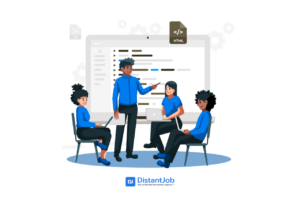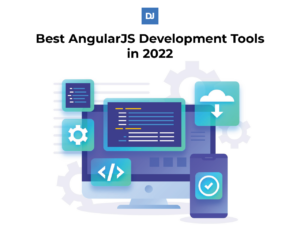What is the best web application framework? Should you go for the most popular web frameworks? Or the most flexible? Or the fastest?
If you are stuck on such questions with no answer in sight, this comparison article is for you.
We understand how difficult and mentally draining it is to pick the right web framework for your project. The wrong framework can negatively affect your website’s speed, consume way too many resources and even affect sales tremendously for businesses.
To assist you in choosing the best web app framework, we have come up with a list of the top 10 frameworks for web applications with the help of seasoned developers.
We will also provide you with a pros and cons comparison table to help you make a quick-bite decision.
Here’s what we’ll be covering so you can quickly skip to the options you want to compare:
- What is a Web Application Framework?
- What are the Types of Web Application Frameworks?
- Best Web Framework Quick Chart Comparison
- Top 10 Web Application Frameworks
Let’s get started.
What is a Web Application Framework?
A web application framework or web development framework is a software tool that is built to develop and run web applications and websites as well as web servers, web portals, web sources, web APIs, and web services.
Benefits of Using a Web Application Framework?
There are numerous advantages of utilizing web application frameworks and we will see these reasons explained in-depth in the last section:
- Rapid development
- Ease of maintenance
- Increased security
- Debugging support
- Increased productivity
What are the Types of Web Application Frameworks?
There are different types of web frameworks and models available for use for both dynamic and static web websites and applications. Depending on your business goals and requirements you can pick the type of framework suitable for you from the below-mentioned options for web application development:
There are two types of web application frameworks:
- Client-side (Frontend) – This is what the user will see when they launch the application. It is the external part of your web application framework.
- Server-side (Backend) – The backend is the background or inner workings of the web application.
What is Backend Framework?
The backend framework or server-side is for the internal development of web applications. It controls the application’s logic, server configurations, security, database, and payment options. With a qualified employee developing the backend framework’s basic architecture and rules, a developer’s productivity is amplified as they can build simple web pages, landing pages, and varying forms of a database with templates.
Simply put, it provides all types of elements that can help you and developers ease up the process. Backend frameworks work individually most times, however, they play a huge role in application growth.
What is Frontend Framework?
Frontend framework development focuses primarily on the creation of a rich user experience. A frontend web framework allows for the manipulation of the feel and appearance of your website to particularly cater to the preferences of your visitors.
Because frontend tools primarily work with web browsers; building a user interface, handling hundreds to thousands of user requests, and managing server requests are the most basic capabilities expected of a developer managing frontend framework development.
Best Web Framework Quick Chart Comparison
Without delay, let’s have a quick look at the comparison chart of the top 10 web application frameworks this year. To make it a lot easier for you, we divided the 10 frameworks into:
- 5 top backend frameworks
- 5 top frontend frameworks
5 Top Backend Web Frameworks Comparison Chart
The table below lists the advantages and disadvantages of the leading 5 server-side or backend web app frameworks. They are used for building the business logic of most web apps.
| Top Backend Framework | Pros | Cons |
| Laravel | Provides convention rather than MVC framework and configuration. It has a huge developer community on platforms like GitHub. Offers packaging scheme with devoted dependency management. Details are well-documented. It has a fast building cycle. | Web developers may encounter problems when executing. It is a new/fresh web application development platform. Reverse routing becomes very hard. |
| Django | Django is secure. It is an excellent pick for MVP. The web app framework provides scalability and flexibility. Well-documented collection. | It isn’t the fastest option. Django is monolithic. |
| ExpressJS | It is very flexible. ExpressJS is one of the most simple backend frameworks available. The framework offers packages for developing API. | It features an obstructive error message. ExpressJS has several default call-backs. It isn’t the preferred choice for heavy web applications or any type of complexity. |
| Ruby on Rails | Seamless procedure of test automation. It provides MVC framework, ample libraries and adequate tool access. Fast application development. The preferred choice for prototyping. | Missing appropriate citations. Boot-time is quite sluggish. Ruby on Rails isn’t the preferred choice for large applications. |
| Spring | Spring is very flexible. It is the most seamless alternative to collaboration with a ton of other programming frameworks. A great pick for Java web applications. | It has a steep learning curve. It may be a tad bit unbalanced. |
5 Top Frontend Web Frameworks Comparison Chart
The table below shows a comparison of frontend web application frameworks by looking at their advantages and disadvantages. These frameworks are used for building powerful and rich user interfaces.
| Top Frontend Frameworks | Pros | Cons |
| Flutter | This web application framework provides Hot Reload responses. It requires less code. It supports cross-platform development. Flutter is one the top picks for MVP. | Flutter primarily supports mobile applications. But with updates such as Flutter on the Web developers can reach users on browsers. It provides less support for Apple TV and Android TV apps. It has limited libraries. |
| Angular | It is seamless to transcribe tests with Angular. This framework is best for developing single-page apps. Angular offers TypeScript support for developing large applications. It offers a fast development approach. It is the preferred choice for MVPs and prototyping. | No CLI documentation. It is very hard to learn. Angular may have trouble when loading large quantities of data. |
| React | It has an extensive tool set. React features a computer-generated DOM for an advanced browsing experience. Ensures a steady code with a single-direction code flow. The MVC framework and all its components are installed. | No clear documentation. It isn’t as straightforward as JavaScript and it is marginally verbose. |
| Ember | Ember possesses a custom debugger. It uses accessors for top-notch performance. Quick development. It is well-documented and features the MVC framework. | Ember isn’t preferred for small projects. It is difficult to learn. It offers very slow rendering. |
| Vue.js | It is very easy to collaborate with other applications. It has clear documentation. You can discover errors with Vue.js very quickly and easily. Vue.js provides a fast development approach. | It is too flexible. Vue.js does not possess a couple of stable components. |
With this out of the way, we will look at all of these frameworks closely, examining their features and practicality (the real-world use cases of the framework). But before that, let’s quickly look at the definition of a web application framework and the meaning of frontend and backend frameworks.
Top 10 Web Application Frameworks
In this section, we will look at the most popular web frameworks:
1. React Framework (Frontend)
Although most developers handle it as a framework, React is a JavaScript frontend library. React.js, according to stateofJS, is the 2nd most popular web application framework for JavaScript due to its first-of-a-kind component-based architecture.
The web application framework features attributes that allow for a quick and comparative straightforward user interface formation; this is its core purpose of usage.
React.js is also an MVC (Model-View-Controller) framework. The Model-View-Controller is an architectural pattern that divides an application into 3 primary logical components: the model, view, and the controller. MVC is used to develop extensible and scalable projects.
The major brands using React include:
- Codecademy
- UberEats
- Netflix
Another major feature that React offers is React Fiber. It is a fully backward-compatible rewrite of the previous reconciliation algorithm.
React Fiber is impacting the center of React from stack callbacks to its representation of the DOM tree. It even introduces React developers to a seamless way of adding layouts, gestures, and animations.
React.js in addition to this also uses JCX syntax which ensures that the DOM manipulation is a lot faster than it normally is.
One of its core application aspects is its mobile application for iOS using React Native and mobile application development for Android as well as interface creation.
Standout Features
- JCX syntax for quick DOM manipulation.
- React Native for mobile application development.
- React Fiber for ease of development.
- It is an MVC framework.
- Component based architecture.
2. Ruby on Rails Framework (Backend)
Ruby on Rails or RoR for short, is an MVC or Model View Controller framework built in Ruby programming language by David Heinemeier Hansson.
It is typically termed as one of the most beginner-friendly frameworks as it helps beginners to start web application development very fast. Ruby on Rails professionals can benefit from its many tools such as tons of databases and abundant libraries that cut down on build time.
It is also excellent for test automation which is a great feature to check your software’s framework quality. RoR is used for developing cloud-based web applications, eCommerce platforms, and social networking websites.
A great example of brands that use Ruby on Rails include:
- Shopify
- Hulu
- Pixlr
- Airbnb
- ASKfm
- GitHub
There are so many perks that Ruby on Rails offers as well as library-like dependencies that boost your site’s functionalities and emphasize the view-layer topics.
This amplifies the ability to develop apps more competently and faster. The Rails community is also quite reliable and friendly and there are tons of tutorials and resources available to help you become a guru very fast.
Standout Features
- Library-like dependencies for view-layer emphasis.
- Adequate number of support resources (tutorials and a vibrant community) to quicken the learning curve.
- Test automation
- It is a Model View Controller framework.
- Huge number of databases and libraries.
3. Flutter Framework (Frontend)
Flutter is fully JavaScript-free because it is a framework written in Dart. Dart is a language developed by Google for creating server-side web applications for desktops.
You can implement Flutter to develop Android applications and mobile iOS and even create network applications for Google’s Fuchsia OS.
Some of the leading websites that use Flutter include:
- Alibaba
- Tencent
Also, this programming framework does not demand any UI components because they were applied previously to the language. This is how web applications like games written in this framework get to their highest speed.
In addition, it supplies widgets only when required, the Hot-Reload scheme helps the platform to re-create and focus the widget tree from the start.
Standout Features
- Zero demand on UI components as they’re already included. This boosts app speed.
- Widget supply is only on request.
- Flutter is extremely flexible and can be used for any interface type (mobile, desktop, tablet, etc).
4. ExpressJS Framework
ExpressJS is seamless to use and manage, especially if you already know Node.js. Speed and simplicity are the primary ideologies of this Node.js API framework.
The frontend framework delivers certain essential topics without hiding the traits of Node and even pushes an obvious display of asynchronous Node.js. ExpressJS is extremely flexible and helps in developing web pages, complete websites, REST API, and web applications.
Out of most open-source frameworks, Express.js features a large number of standout web development tools and many solutions that you can create with just a couple of code lines.
It works seamlessly with supplementary frameworks such as Loopback, Sails, and Kraken. You can also augment middleware technique routes and HTTP like post, get, and put, to an application (router).
These days Express.js is quickly becoming one of the most popular and best frameworks for web application development. Popular companies that use ExpressJS include:
- Uber
- IBM
- Accenture
Standout Features
- It allows for middleware augmentation to routers.
- No requirement for code verbosity to create solutions.
- Works seamlessly with Node.js
- ExpressJS is extremely flexible and can be used to develop different types of applications.
5. Ember Framework (Frontend)
Ember.js is amongst the most trusted JavaScript web application development frameworks. It is an MVC framework that was released in 2011 and has been growing quickly and gaining more popularity in the tech space.
The community for Ember.js is huge and is continuously growing with each new feature and release, which are added regularly. Ember features a two-way user data migration utility and binding which Angular claims. It also provides many components and traits that you can deploy completely.
Brands that utilize Emberjs in their websites include:
- Netflix
- Microsoft
- Heroku
Ember reduces tasks that need ample time and uses JavaScript practices in its core design. The language allows you to make assets out of functions. This is very advantageous with regards to functioning with bindings. The central characteristics of Emberjs are its support for both all technologies and most contemporary standards, advanced version management system, and very strict organization.
Standout Features
- Transforms functions to assets.
- It offers support flexibility as it is compatible with nearly all languages.
- Ember provides strict code organization.
- Ember utilizes JavaScript
- It is an MVC framework
- 2-way user data-migration utility and binding.
6. Laravel Framework (Backend)
Laravel utilizes the PHP language and is an open-source web application development framework. The language is backed by API support and it contains several PHP packages and components capable of spreading out its influence.
Newer versions like Laravel 8 include enhancements to the webpages by offering implicit model binding, simplified eloquent global scopes, model factory classes, migration squashing, middleware groups, and multiple authentication driver support. It also features out of the box an opt-in authentication scaffolding, rate-limiting middleware, array validation improvements, and lots more. These features make it a great choice for eCommerce websites.
Laravel is an MVC architectural pattern framework built by Taylor Otwell and it has fought to be one of the most popular PHP frameworks. Regarding documentation support, it offers Laracasts, which are screencast tutorials on their website with videos on Laravel, PHP frameworks, and front-end technologies, in a Laravel environment that is beneficial for every beginner.
You can also fetch entire Laravel source codes via GitHub under the terms and conditions of the license.
While Laravel is the newest concept when compared to others in this programming framework list, it is also one of the top web frameworks for companies looking for efficient and quick web application development.
Standout Features
- Laravel is open-source
- Adequate support on their website with screencast tutorials.
- It contains PHP packages and components.
- It uses the PHP language.
- Laravel offers rate-limiting middleware
- It is a Model View Controller framework
- Laravel features opt-in authentication scaffolding, implicit model binding, simplified eloquent global scopes, model factory classes, and migration squashing.
7. Vue.js Framework (Frontend)
This language is quickly becoming the most popular JavaScript framework available (currently 3rd). Vue.js is an advanced framework that allows you to adapt Vue for a section of your existing idea while everything else would run as stated (set) originally.
Due to its seamless construction, Vue solves all complexities easily. It also features functions that render a component-based design to run and its ecosystem can help you to create frontend applications.
Vue.js provides a minimalistic, efficient, and lightweight approach to developing the frontend and this has caused it to gain quick traction.
There are a ton of frameworks available for Vue development as well. With such features and compatibility, it isn’t a shocker that in such a short time the language has become one of the top 3 JavaScript frameworks alongside Svelte and React.
Standout Features
- Simplicity
- Virtual DOM
- Flexibility
- Two-way data binding
- View-layer focused framework
8. Spring Framework (Backend)
Spring is built on Java and possesses an MVC framework created by Pivotal software. The core purpose of this framework language is the ability to develop the formation of J2EE applications.
Its HTTP Post and organized architecture ease up the whole process a lot. Numerous prominent corporations have reaped the benefits of controller classes and spring MVC. Some organizations using the minimalistic and lightweight approach of Spring for developing robust websites include the following:
- TicketMaster
- Wix
- BillGuard
Spring is a lightweight container and provides API responses for many domains which are highly advantageous to web developers and websites. The features of the Spring framework have the benefits of retaining numerous parallel projects and improving the functionality that helps you in scaling up your business response quickly.
It also provides standard features like the employment of Java, a strong type of programming language.
Standout Features
- It is a lightweight container
- Organized architecture
- Develops the formation of J2EE applications
- It is built on Java
- It is an MVC framework
- Spring enables the full utilization of controller classes
9. Angular Framework (Frontend)
Angular is generally accepted to be the best web framework for creating rich single-page web apps or SPAs. The framework possesses the ability to build complete client-side applications. Angularjs 1.x is utilized in JavaScript but the latter updates took on TypeScript – a super subset of JavaScript. It was created by Google.
Brands that use Angular include:
- PayPal
- Microsoft
It requires less care and provides high-level performance due to its rich features like two-way data binding and dependency injection. Some other functions of the language that enhance speed and productivity are Command Line Tools (CLI) and template syntax for sanctioning quick prototypes.
Standout Features
- Template syntax for sanctioning prototypes quickly.
- It excels in creating single-page web applications.
- Dependency injection
- 2-way data binding
- Command Line
10. Django Framework (Backend)
Django programming language is open-source and developed on the Python full-stack web framework. It is a Model View Template pattern and is considered to be among the best architecture designs for web application frameworks.
It supports database access and Python latest version and offers an admin panel for building websites developed with Python language. It features batteries-included traits that provide a variety of properties which consist of authentication and messaging. It adheres to the Convention over Configuration philosophy as well as DRY concepts.
Django web application framework enables web developers to handle user accounts, create a secure website, and implement security features in the framework such as averting code performance within the template layout.
Some of the leading brands that use Django for developing websites include:
- YouTube
Standout Features
- It adheres to the Convention over Configuration philosophy and DRY concepts.
- Django is open-source
- It follows an MVT pattern
- It provides an admin panel
- Database access and Python support
What to Know Before Choosing a Web Framework
The choice of the best framework for your web development project depends on numerous varying factors and ideas but you have to consider certain factors before going ahead and putting resources in it.
To save you time and effort, we have listed the questions/factors to consider before choosing the best web application development framework for your task:
- Is the framework open-source?
- Have you put their licensing into consideration?
- The availability of plugins and documents for the framework.
- Does it provide the option of default unit testing systems?
- What are its protection and security features?
- Does it constantly receive updates and what are the future support, trends, and maintenance options for an application built with the framework?
- What is its ease of use for startups or beginners as well as the learning curve patterns?
- How old is the web framework?
Why Use Web Frameworks
A web application framework isn’t necessary for developing a web application. However, it certainly provides tools that can ease the process and make it stress-free. Using a framework is the best practice as the core processes of developing, testing, and maintaining apps become nearly impossible without it.
Let’s talk about some of the features of web application frameworks that make them vital development tools for web developers.
1. Programming Language Simplification
Frameworks are most times necessary for adequately working with complicated programming languages as they can offer integrable and understandable functions. For instance, working with JavaScript requires the developer to write large lines of code for managing data consistency throughout the web app. However, frameworks such as React do this automatically.
In like manner, they automate many other tasks by offering built-in functions that would otherwise be complicated for developers. Every major language has multiple frameworks for varying usage requirements.
2. Development Process Optimization
Web frameworks are an excellent approach to bootstrapping the development cycle. Web developers who are working under strict time and budget constraints should go for popular open-source frameworks as mentioned above. It is recommended to use Vue or React to quickly develop client-side applications and Ruby on Rails for creating MVPs (Minimum Value Products) overnight.
You can create custom applications within short time frames developing ready-made templates according to your specific needs. Web frameworks also offer massive flexibility to web developers for testing and implementing creative solutions.
3. Reusability
A major advantage of using web frameworks is reusability. It fosters the development of reusable components that you can integrate into other aspects of the code and even in unique projects. Reusability boosts maintainability, data consistency, and productivity, especially in big applications with a large development team. Because developers won’t have to write everything from the bottom up it provides them the time of focusing on the development of the application logic.
4. Testing and Debugging
Many frameworks offer testing and debugging features. With the code reusability options, your web apps are already understandable and better maintained and combined with other functions such as code completion, unit testing, simultaneous code editing, updating and managing your application become very easy.
5. Standard Code Practices
A lot of the available web frameworks use a particular code structure that must be followed. This ensures uniformity throughout your application as well as streamlines the debugging process.
It also makes your code concise and simple. For instance, a lot of libraries and frameworks adhere to the material design guidelines by Google. Though this may be a hindrance to certain developers’ flexibility, if you are a fresher or beginner or working with a large team these standardized practices help ensure readability and consistency.
Get Started with the Best Web App Frameworks
As we have just seen back-end and front-end web development frameworks act as crucial elements for developing web applications. So in this comparison article, we have reviewed some of the most popular and best web frameworks that you can pick for your upcoming or current web project.
The selection of a web application framework for your website must be dependent on the specific details of a particular product. This is because every web developer or enterprise thinking about building a web application may have different influences which ultimately affect use capability.
If you are unsure how to begin or are stuck in the middle of the development procedure, DistantJob, an IT staffing agency, can help you and your team with hiring the right developer for your project. Or if you are a developer seeking to put your skills to work visit here for job opportunities.
Meta
An in-depth review of the best web application framework covering Ruby on Rails, Angular, Vue,js, Ember.js, Django, Laravel, Spring, Flutter, and much more.





